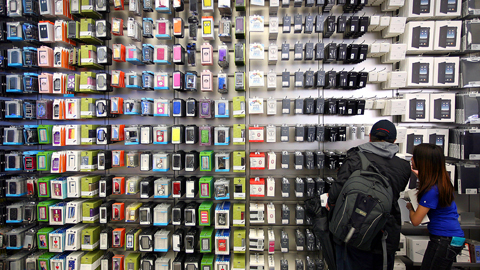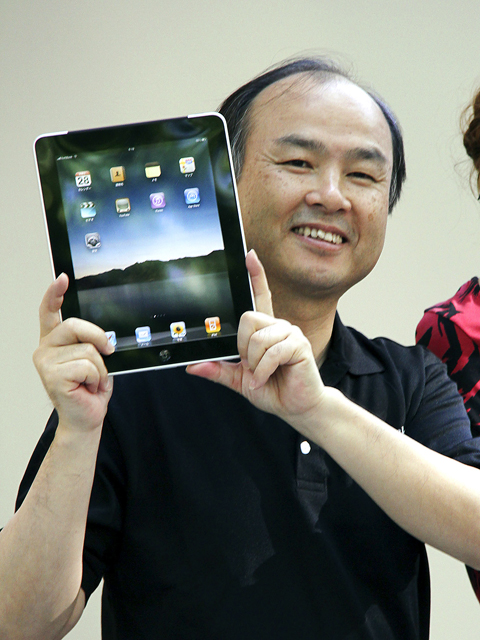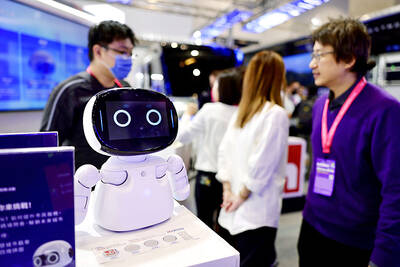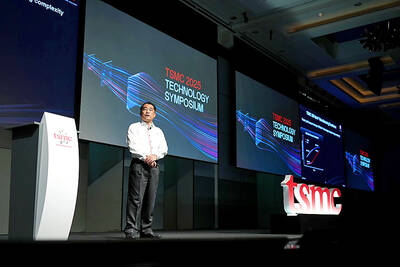Thousands of fired up and sleep-deprived gadget fans mobbed shops in Australia and Japan yesterday as Apple’s iPad, touted as a revolution in computer use and publishing, began its international launch.
A line some 200m long stretched round the block at Apple’s flagship central Sydney store, flummoxing commuters bemused by the hype, while similar scenes played out in downtown Tokyo.
The iPad — a flat, 25cm black tablet targeted at the leisure market — was also going on sale in Britain, Canada, France, Germany, Italy, Spain and Switzerland yesterday as part of a staggered global roll-out.

PHOTO: BLOOMBERG
In central London about 40 enthusiasts clad in sleeping bags and blankets were lining up in the middle of the night outside the city’s cavernous Apple store.
In Sydney, security guards had to quell pushing and shoving amongst the media as Rahul Koduri, who lined up for 30 hours from 2am on Thursday, became the first to buy the touch-screen computer.
“It’s fantastic, it was so worth the wait,” said the 22-year-old, brandishing two iPad boxes after his long wait in the chill of the late Australian autumn.

PHOTO: BLOOMBERG
The international launch date was pushed back by a month after huge demand in the US, where 1 million iPads were sold in the first 28 days after the product’s debut early last month.
Prices in Japan and Australia for the basic 16GB iPad are comparable to US prices, once sales tax is included, although a significant markup by Apple in Britain and continental Europe has triggered some grumbling.
In Australia a 64GB version that runs on advanced 3G phone networks is priced at A$1,049 (US$889), which in sterling terms is around 13 percent cheaper than in Britain. In Japan, whose corporate giants once ruled the technology roost, more than 1,000 buyers lined up in front of Apple stores and outlets of its exclusive local partner, mobile phone carrier Softbank, along with big electrical shops.
Media crews flocked to the stores as broadcasters flew helicopters to gain aerial views of a 1,200-strong line at the Apple store in Tokyo’s Ginza shopping district.
Kazuki Miura, a 38-year-old freelance technology writer wearing a home-made iPad headpiece, was the first to get his hands on the gadget at Softbank’s main Tokyo store.
“Now the time has come for us to hold an iPhone in the right [hand] and iPad in the left — just like the samurai with two swords,” Softbank president Masayoshi Son said at an in-store presentation.
The multi-functional device is tipped by some pundits to revitalize media and publishing, with many major newspapers and broadcasters launching applications.
However, in Japan, content providers including powerful newspaper groups — less affected by the market downturn that is roiling media groups in the West — are taking a wait-and-see approach about rolling out iPad “apps.”
On London’s upmarket Regent Street, Jake Lee, a 17-year-old student from Essex, was at the front of the line with two friends after a 15-hour wait that had stretched since midday on Thursday.
The group had received “a few weird looks” and an offer of £200 (US$290) to give up their places at the front of the line, but they refused.
“It’s for us, we don’t want to give it to anyone else,” Lee said.
California-based Apple plans to bring the iPad to Austria, Belgium, Hong Kong, Ireland, Luxembourg, Mexico, the Netherlands, New Zealand and Singapore in July.
More than 5,000 apps have been developed for the device, according to an Apple spokesman, in addition to the 200,000 programs already available for the iPhone and iPod Touch, most of which run on the iPad.
Capital Markets analyst Mike Abramsky estimated that Apple is selling more than 200,000 iPads a week — more than estimated Mac computer sales of 110,000 a week, and vying with iPhone 3GS sales of 246,000 a week.
Apple has declined to reveal the number of pre-orders received for the iPad internationally, but Abramsky put it at around 600,000.

DEMOGRAPHICS: Robotics is the most promising answer to looming labor woes, the long-term care system and national contingency response, an official said Taiwan is to launch a five-year plan to boost the robotics industry in a bid to address labor shortages stemming from a declining and aging population, the Executive Yuan said yesterday. The government approved the initiative, dubbed the Smart Robotics Industry Promotion Plan, via executive order, senior officials told a post-Cabinet meeting news conference in Taipei. Taiwan’s population decline would strain the economy and the nation’s ability to care for vulnerable and elderly people, said Peter Hong (洪樂文), who heads the National Science and Technology Council’s (NSTC) Department of Engineering and Technologies. Projections show that the proportion of Taiwanese 65 or older would

Nvidia Corp yesterday unveiled its new high-speed interconnect technology, NVLink Fusion, with Taiwanese application-specific IC (ASIC) designers Alchip Technologies Ltd (世芯) and MediaTek Inc (聯發科) among the first to adopt the technology to help build semi-custom artificial intelligence (AI) infrastructure for hyperscalers. Nvidia has opened its technology to outside users, as hyperscalers and cloud service providers are building their own cost-effective AI chips, or accelerators, used in AI servers by leveraging ASIC firms’ designing capabilities to reduce their dependence on Nvidia. Previously, NVLink technology was only available for Nvidia’s own AI platform. “NVLink Fusion opens Nvidia’s AI platform and rich ecosystem for

Taiwan Semiconductor Manufacturing Co (TSMC, 台積電) yesterday said it is building nine new advanced wafer manufacturing and packaging factories this year, accelerating its expansion amid strong demand for high-performance computing (HPC) and artificial intelligence (AI) applications. The chipmaker built on average five factories per year from 2021 to last year and three from 2017 to 2020, TSMC vice president of advanced technology and mask engineering T.S. Chang (張宗生) said at the company’s annual technology symposium in Hsinchu City. “We are quickening our pace even faster in 2025. We plan to build nine new factories, including eight wafer fabrication plants and one advanced

‘WORLD’S LOSS’: Taiwan’s exclusion robs the world of the benefits it could get from one of the foremost practitioners of disease prevention and public health, Minister Chiu said Taiwan should be allowed to join the World Health Assembly (WHA) as an irreplaceable contributor to global health and disease prevention efforts, Minister of Foreign Affairs Lin Chia-lung (林佳龍) said yesterday. He made the comment at a news conference in Taipei, hours before a Taiwanese delegation was to depart for Geneva, Switzerland, seeking to meet with foreign representatives for a bilateral meeting on the sidelines of the WHA, the WHO’s annual decisionmaking meeting, which would be held from Monday next week to May 27. As of yesterday, Taiwan had yet to receive an invitation. Taiwan has much to offer to the international community’s